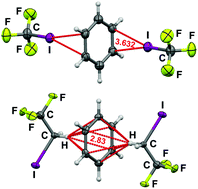The nature of interactions of benzene with CF3I and CF3CH2I†
Abstract
In situ grown crystals of CF3I and CF3CH2I are dominated by I⋯I and F⋯F interactions. Their co-crystals with benzene, (CF3I)2·C6H6 and CF3CH2I·C6H6, contain two completely different sets of intermolecular interactions. (CF3I)2·C6H6 shows a unique halogen-bond type: above-the-bond C–I⋯πC6H6 interactions. CF3CH2I·C6H6 shows above-the-centre C–H⋯πC6H6 interactions. These interactions are electrostatically dominated type II halogen bonds between single halogenoalkane molecules and weaker dispersion dominated interactions between the co-crystal components. The observed preferences for benzene for the two binding partners match with calculated molecular electrostatic potentials.

- This article is part of the themed collection: 1st International Conference on Noncovalent Interactions


 Please wait while we load your content...
Please wait while we load your content...